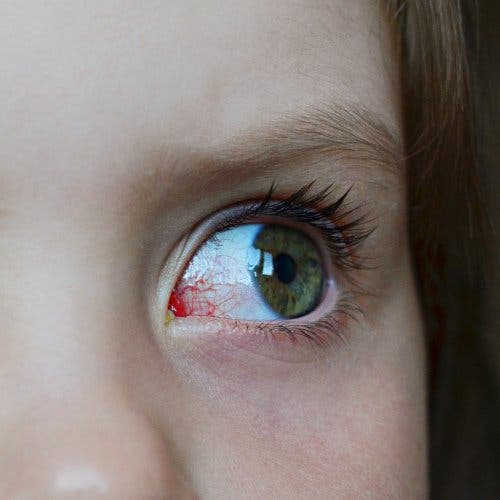How to Detect and Treat Glaucoma in Children


Written and verified by the pharmacist Sara Viruega Encinas
Glaucoma is an illness that takes place in the eyes and can produce total loss of vision. In the article below, we’ll talk about how to detect and treat glaucoma in children. We’ll also look at why it occurs and possible consequences.
What is glaucoma?
As we’ve said, glaucoma is a condition that affects the eyes. It’s mainly characterized by an increase in intraocular pressure as a result of a lack of drainage of the aqueous humor fluid.
To understand it, it’s important to understand a bit about the structure of this organ. First of all, the protective white covering around the eye is the sclera. And, at the same time, there is another layer of protection around the sclera known as the conjunctiva.
In the front part of the eye, we have the cornea, which is the transparent area that allows light to come in. In this area, we also find the iris, which expands and contracts so the pupil can let in a greater or lesser amount of light.

The light that enters is directed toward the crystalline, which is a sort of lense. The crystalline then projects light on the internal coating of the eye, called the retina. There, nerve fibers are responsible for carrying the information they get from the optic nerve to the brain.
Within the ocular structure, we find the following liquids:
- Aqueous humor: We find this liquid in the inner chamber of the eye, nourishing the eye and the crystalline.
- Vitreous humor: This liquid is denser than the aqueous humor, and is located between the crystalline and the retina. The vitreous humor is responsible for maintaining the shape of the ocular globe.
Today we’re going to focus specifically on the humor aqueous since it’s what causes glaucoma. The balance between the production and elimination of humor aqueous is what maintains the correct intraocular pressure. In this sense, two pathological situations can occur:
- An increase in the production of aqueous humor.
- A decrease in the elimination or drainage of aqueous humor.
Why does glaucoma occur?
In short, glaucoma is the result of an increase in intraocular pressure. In general, what causes this pressure is a deficit in the drainage of aqueous humor. This deficit leads to an accumulation of this liquid, thus increasing pressure and damaging the optic nerve.
There are two main types of glaucoma:
- Chronic open-angle glaucoma: This is the most common form of glaucoma. It occurs gradually as a result of an accumulation of liquid and doesn’t produce damage or sudden changes in vision.
- Narrow-angle glaucoma or angle-closure glaucoma: This is generally an acute form of glaucoma. Ocular pressure increases rapidly because the iris blocks the drainage angle. It produces sudden and quite alarming symptoms, such as:
- Blurry vision.
- Intense pain in the eyes.
- Headache.
- Nausea and vomiting.
Glaucoma in children
Glaucoma in children is also known as childhood, pediatric, congenital, or juvenile glaucoma. Although different classifications exist, we can identify three different types of glaucoma in children:

- Congenital glaucoma: This is a rare congenital anomaly that’s not caused by any other disorder. It can affect just one eye or both and appears in babies and small children.
- Secondary glaucoma: In this case, glaucoma is the result of a lesion, surgery, or another illness, such as Sturge-Weber syndrome. It is not common.
- Developmental glaucoma: It’s associated with ocular and systemic anomalies present at birth.
Glaucoma in children can produce certain symptoms, such as:
- Enlargement of the eyes due to dilation of the sclera and the cornea as a result of increased ocular pressure.
- Cloudiness of the cornea.
- Excessive tearing.
- Redness in the eye.
- Photophobia: Sensitivity or pain in the eyes when exposed to light.
How to prevent glaucoma in children?
If untreated, glaucoma in children can lead to total blindness. This is because of the damage that it produces to the optic nerve by increasing intraocular pressure.
It’s possible to avoid this damage through surgery, creating a new liquid drainage system in the eye. Other more conservative treatments control ocular pressure through the administration of pharmaceuticals in the form of eye drops.
In short, if you notice a loss of vision in your child, whether sudden or progressive, total or partial, you should consult a doctor. An ophthalmologist will be able to determine quickly if glaucoma is to blame or not, as well as prescribe any necessary treatment.
Glaucoma is an illness that takes place in the eyes and can produce total loss of vision. In the article below, we’ll talk about how to detect and treat glaucoma in children. We’ll also look at why it occurs and possible consequences.
What is glaucoma?
As we’ve said, glaucoma is a condition that affects the eyes. It’s mainly characterized by an increase in intraocular pressure as a result of a lack of drainage of the aqueous humor fluid.
To understand it, it’s important to understand a bit about the structure of this organ. First of all, the protective white covering around the eye is the sclera. And, at the same time, there is another layer of protection around the sclera known as the conjunctiva.
In the front part of the eye, we have the cornea, which is the transparent area that allows light to come in. In this area, we also find the iris, which expands and contracts so the pupil can let in a greater or lesser amount of light.

The light that enters is directed toward the crystalline, which is a sort of lense. The crystalline then projects light on the internal coating of the eye, called the retina. There, nerve fibers are responsible for carrying the information they get from the optic nerve to the brain.
Within the ocular structure, we find the following liquids:
- Aqueous humor: We find this liquid in the inner chamber of the eye, nourishing the eye and the crystalline.
- Vitreous humor: This liquid is denser than the aqueous humor, and is located between the crystalline and the retina. The vitreous humor is responsible for maintaining the shape of the ocular globe.
Today we’re going to focus specifically on the humor aqueous since it’s what causes glaucoma. The balance between the production and elimination of humor aqueous is what maintains the correct intraocular pressure. In this sense, two pathological situations can occur:
- An increase in the production of aqueous humor.
- A decrease in the elimination or drainage of aqueous humor.
Why does glaucoma occur?
In short, glaucoma is the result of an increase in intraocular pressure. In general, what causes this pressure is a deficit in the drainage of aqueous humor. This deficit leads to an accumulation of this liquid, thus increasing pressure and damaging the optic nerve.
There are two main types of glaucoma:
- Chronic open-angle glaucoma: This is the most common form of glaucoma. It occurs gradually as a result of an accumulation of liquid and doesn’t produce damage or sudden changes in vision.
- Narrow-angle glaucoma or angle-closure glaucoma: This is generally an acute form of glaucoma. Ocular pressure increases rapidly because the iris blocks the drainage angle. It produces sudden and quite alarming symptoms, such as:
- Blurry vision.
- Intense pain in the eyes.
- Headache.
- Nausea and vomiting.
Glaucoma in children
Glaucoma in children is also known as childhood, pediatric, congenital, or juvenile glaucoma. Although different classifications exist, we can identify three different types of glaucoma in children:

- Congenital glaucoma: This is a rare congenital anomaly that’s not caused by any other disorder. It can affect just one eye or both and appears in babies and small children.
- Secondary glaucoma: In this case, glaucoma is the result of a lesion, surgery, or another illness, such as Sturge-Weber syndrome. It is not common.
- Developmental glaucoma: It’s associated with ocular and systemic anomalies present at birth.
Glaucoma in children can produce certain symptoms, such as:
- Enlargement of the eyes due to dilation of the sclera and the cornea as a result of increased ocular pressure.
- Cloudiness of the cornea.
- Excessive tearing.
- Redness in the eye.
- Photophobia: Sensitivity or pain in the eyes when exposed to light.
How to prevent glaucoma in children?
If untreated, glaucoma in children can lead to total blindness. This is because of the damage that it produces to the optic nerve by increasing intraocular pressure.
It’s possible to avoid this damage through surgery, creating a new liquid drainage system in the eye. Other more conservative treatments control ocular pressure through the administration of pharmaceuticals in the form of eye drops.
In short, if you notice a loss of vision in your child, whether sudden or progressive, total or partial, you should consult a doctor. An ophthalmologist will be able to determine quickly if glaucoma is to blame or not, as well as prescribe any necessary treatment.
All cited sources were thoroughly reviewed by our team to ensure their quality, reliability, currency, and validity. The bibliography of this article was considered reliable and of academic or scientific accuracy.
- Roche Caso, S., Triana Casado, I., Molina Cisneros, C., Ricardo Lorenzo, R., & Cabezas García, A. (2011). Caracterización del glaucoma juvenil. Revista Cubana de Pediatría, 83(1), 34-43.
- Pérez Díaz, L., & Nápoles García, A. D. (2011). Glaucoma del desarrollo: diagnóstico, tratamiento quirúrgico y seguimiento integral. Medisan, 15(8), 1079-1090.
- Urcelay, J. L. (2004). Glaucoma congénito. Tratamiento médico¿ cuándo y cómo. Boletín de la Soc Oftalmo de Madrid [Internet], 44.
This text is provided for informational purposes only and does not replace consultation with a professional. If in doubt, consult your specialist.








